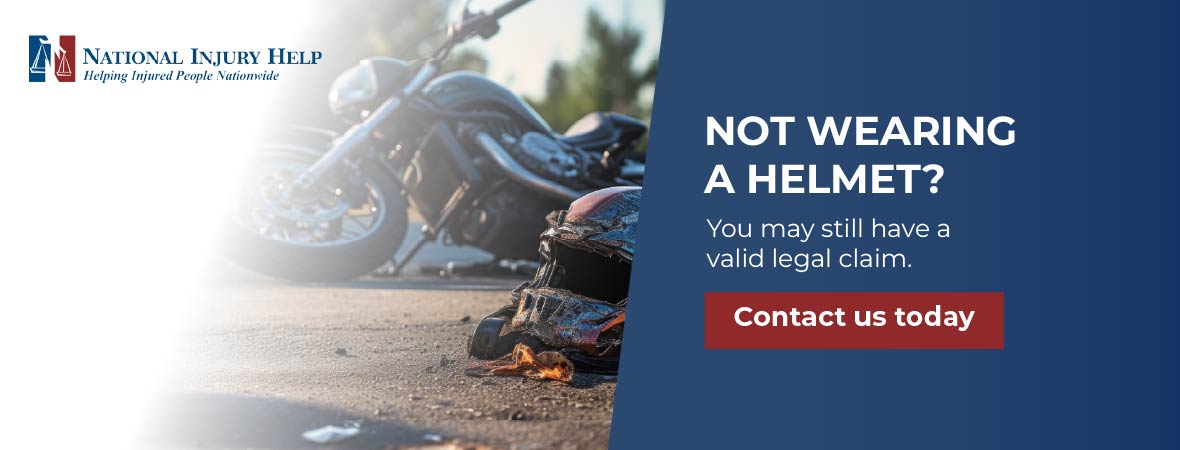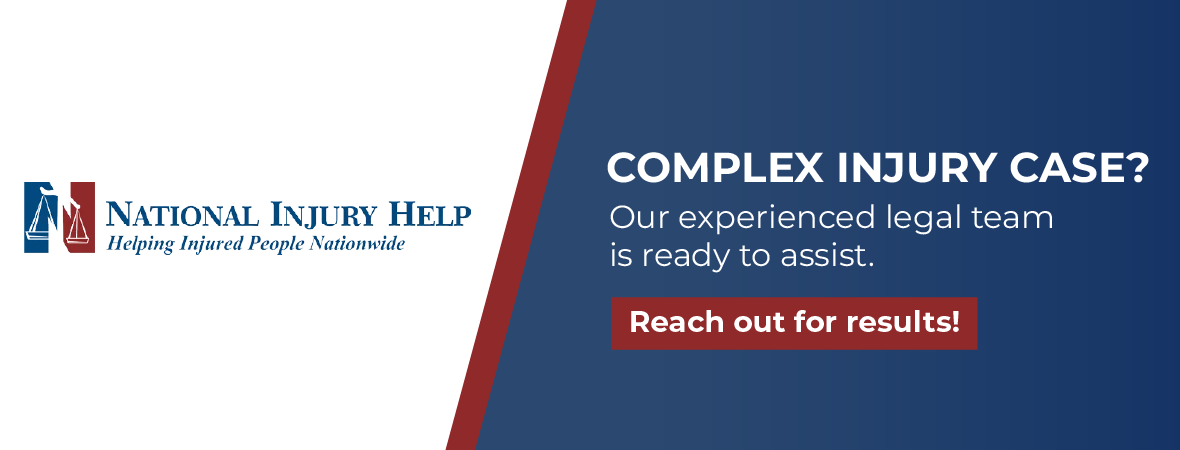Helmet laws can affect how motorcycle accident claims are handled, especially when it comes to injury compensation. If you were injured in a motorcycle crash, contact National Injury Help. We will guide you through every step and fight for what you deserve.
There’s nothing quite like riding a motorcycle. Whether you’re winding through mountain roads at sunrise, coasting along the coast, or taking in the open skies of the Midwest, the experience is a mix of freedom, focus, and thrill. But that freedom comes with real risk. Unlike drivers in cars or trucks, motorcyclists don’t have the protection of metal frames, seatbelts, or airbags. When another driver makes a careless move, it’s often the rider who suffers the most serious injuries.
What happens next can be just as overwhelming. You may face police reports, hospital visits, calls from insurance adjusters, and complex state laws that change from one place to the next. Navigating all of it can feel like a second crash, one that takes a toll on your time, energy, and finances.
One issue that often comes up after a motorcycle accident is the helmet question: Were you wearing one, and if not, could it affect your case? The answer depends on where the crash happened. Helmet laws vary widely. Some states require helmets for everyone, others only for younger riders, and a few leave it up to personal choice. But even in states where helmets aren’t required, insurance companies may try to use your choice against you, arguing that it shows recklessness or contributed to your injuries.
Each state also applies its own rules for assigning fault. In some places, being found partially at fault can lower your compensation. In others, it can block recovery entirely. That’s why understanding how helmet use and fault laws interact is so important if you want to protect your rights after a crash.
Helmet Laws in the United States
Motorcycle helmet laws in the U.S. vary a lot from state to state. Some, like California and New York, require all riders and passengers to wear helmets, no matter their age. Others, like Texas and Florida, only require helmets for younger riders, usually under 18 or 21. And a small handful, such as Iowa and Illinois, don’t have any motorcycle helmet law at all.
If you’re taking a long ride across state lines, these changing rules can get confusing fast. Take a simple trip from St. Louis to Louisville, for example. You might not need a helmet in Illinois, but once you cross into Kentucky, the rules shift, especially for younger riders or those without added insurance. Then, once you’re back in Missouri, you might face yet another set of requirements depending on your age or experience level. Slipping up, you could end up with a ticket, and that could hurt your case if you’re ever in a crash and need to file a claim.
Even in states where helmets aren’t required, plenty of riders still choose to wear them. Riding groups, dealerships, and safety advocates often encourage it. Today’s helmets are light, well-ventilated, and designed for comfort. And the stats are hard to ignore, helmets can reduce the risk of a serious head injury by nearly 70%, and the risk of death by more than 40%.
No matter what the law says, putting on a helmet is one of the smartest moves you can make, no matter where you ride. More and more bikers are choosing safety first, every ride, every time.
Fault Rules That Shape Injury Claims
Three main rules can affect your motorcycle accident claim.
- Pure comparative fault states let you recover money even if you are ninety-nine percent at fault. Your award simply shrinks by your percentage of blame. New York and California are examples.
- Modified comparative fault states allow recovery only if your fault stays below a cut-off, usually fifty or fifty-one percent. Texas and Colorado use this model.
- Contributory negligence states bar recovery entirely if you share even one percent of the blame. Only a few states still follow this harsh rule, including Maryland and North Carolina.
Why does that matter? Because insurance lawyers argue that skipping a helmet means you share fault for any head injury, which can reduce your compensation significantly.
How Insurance Companies Use Helmet Evidence
When an adjuster sees the phrase “no helmet” in a crash report, several strategies come out of the playbook.
- Causation attack. The insurer will say your head injury would not exist, or would be far less severe, had you worn approved headgear. They usually support this claim with medical literature and expert doctors who testify about rotational forces and skull protection.
- Mitigation argument. Even if the other driver clearly caused the crash, the insurer claims you failed to take reasonable steps to limit harm, which means you should shoulder a chunk of the medical bill.
- Character framing. Some adjusters try subtle psychology, painting the rider as someone who ignores safety advice and therefore must have been speeding or weaving, even if the evidence is thin.
Each tactic demands a tailored response.
- A lawyer can show that certain brain injuries, such as diffuse axonal injury, stem from sudden rotation that a helmet might not prevent.
- Accident reconstruction experts can demonstrate that the impact direction, speed, and vehicle weight would have caused injury regardless of headgear.
- Cross-examination can expose bias if the defense doctor routinely testifies for insurers.
The key point is that helmet evidence must be tied specifically to the injuries claimed. A missing helmet has nothing to do with broken legs, road rash on the torso, or a shattered wrist.
Steps to Take Right After a Motorcycle Crash
Here’s what you should do if you’ve been involved in a motorcycle crash.
- Get medical help immediately. Even if you feel fine, adrenaline can hide a concussion or internal bleeding. Early treatment also creates a clear medical record, which is gold in a legal claim.
- Call law enforcement. A police report anchors the facts, notes traffic violations, and gathers names. If you suspect the driver was texting or under the influence, tell the officer.
- Document everything. Use your phone to photograph the crash scene, vehicle positions, damage points, and any visible injuries. Snap pictures of your helmet, even if it stayed in the saddlebag, as proof of its condition at the time.
- Collect witness info. People move on quickly. A thirty-second chat and a saved phone number can make or break a liability fight months later.
- Notify your insurer. Most policies require prompt notice, but keep the conversation factual and brief. Decline any recorded statement from the other driver’s insurer until you have legal guidance.
Filing a Motorcycle Accident Claim
After medical care is stable, the claims process begins. In every state in the USA, it will likely unfold in the following way:
- Determine the fault. Your lawyer will order the police report, request any traffic camera or dash camera footage, and may hire an independent investigator. Bias against motorcyclists is real, so the burden often falls on the rider to prove normal, safe behavior.
- Calculate damages. Economic losses include hospital bills, surgery, rehab, medications, lost income, and future treatment costs. Non-economic losses cover pain, emotional distress, loss of hobbies, and scarring. Some states cap these amounts, while others leave them to jury judgment.
- Negotiate or litigate. Insurers frequently lowball first offers, tagging on helmet deductions, speculative speeding claims, or suggesting lane splitting was illegal even in states where controlled filtering is allowed. An experienced lawyer separates myth from law and demands proof for every allegation.
Frequently Asked Questions
Do I automatically lose my case if I was not wearing a helmet?
No. The outcome depends on the injury type, the state’s fault rule, and how well your lawyer counters the insurer’s arguments.
The police officer said I was partly to blame because I violated biker safety regulations by not wearing a helmet. Is that final?
Absolutely not. Police opinions on helmet use and liability carry no legal weight on fault or damages. They can be challenged in court.
What if I was in a state that requires helmets, but I live in one that does not?
You must follow the law where the crash happened. Failure to do so can influence fault percentages, but it does not erase your right to recover damages. It simply becomes a factor to be addressed.
How long do I have to file a lawsuit?
Statutes of limitation vary. Some states give you one year, most give two or three, and a few allow up to six. Government defendants often require notice within months. Contact a lawyer right away to preserve your timeline.
Why Choose National Injury Help
Motorcycle cases are different from car cases, and our seasoned attorneys at National Injury Help can handle these cases. Call us today at 1 (800) 214-1010.
Our firm works on a contingency fee basis. We cover the costs of investigators, medical experts, and accident reconstruction teams. You incur no legal fees unless we secure a settlement or a verdict. This arrangement allows you to concentrate on healing rather than worrying about bills.







